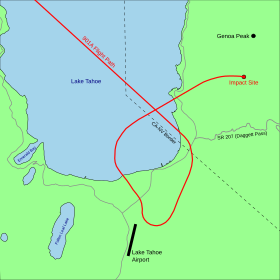Paradise Airlines Flight 901A
On March 1, 1964, the Lockheed L-049 Constellation serving the flight crashed near Genoa Peak, on the eastern side of Lake Tahoe during a heavy snowstorm, killing all 85 aboard.Crash investigators concluded that the primary cause of the accident was the pilot's decision to attempt to land at Tahoe Valley Airport when the visibility was too low due to clouds and snowstorms in the area.After aborting the landing attempt, the flight crew lost awareness of the plane's location as it flew below the minimum safe altitude in mountainous terrain.The airline involved was a two-year-old company that operated discount excursion flights from the San Francisco Bay Area to Lake Tahoe.That crew said that they had encountered icing conditions at 12,000 feet (3,700 m), that there were snow showers over Lake Tahoe, and that clouds had obscured the tops of mountains in the vicinity.[5]: 5 According to Federal Aviation Administration (FAA) regulations for the airport, the weather report had to have a minimum ceiling of 4,000 feet (1,200 m) and 10 miles (16 km) visibility before a commercial passenger aircraft could attempt an approach, so the incoming flight could not be given permission to land.Two small boats searched along a ten-mile (16 km) stretch of the lake's shore, but by nightfall, the searchers had found no trace of the missing aircraft.[6] Rescuers estimated that because of the rugged terrain and the deep snow, it would take several days or possibly even months until after the spring thaw before all the victims could be recovered.[2] The first seven were brought to a makeshift morgue in the CVIC Hall in Minden, Nevada, on March 3, two days after the crash, where technicians from the Federal Bureau of Investigation began the process of identification.[14] An additional 43 victims were brought the next day, with officials hurrying to recover bodies before an incoming snowstorm buried them in the snow, making them even harder to locate.The suspension order said that the airline had shown "a lack of ability and qualifications to conduct a safe intrastate common carrier passenger operation".He was not very fluent with the English language, and in response to questioning by the FAA, was unable to provide explanations of crucial weather terms that appeared in that day's forecast.[31] He testified that he had used his own judgment and predicted that weather conditions at Tahoe Airport would be safe enough for the flight to land by the time it arrived.[34] Another FAA investigator testified that Paradise Airlines had violated civil air regulations several times in the three months before the accident, mostly involving weather conditions.[36] Paradise Airlines president Herman Jones called the hearings "a great miscarriage of justice" and vowed to keep the company's planes flying, with or without an air operator's certificate.[37] FAA representatives countered that if the company attempted to fly without a certificate, the United States Marshals Service would seize the aircraft involved.[5]: 25 According to the FAA, the type of aircraft was well suited for operation in high-altitude, mountainous airports like Lake Tahoe, due to its relatively slow speed and high maneuverability.A salvage operator began removing the rest of the plane, taking the pieces to a warehouse at Reid–Hillview Airport near San Jose and storing them there in case they were needed by CAB investigators.[44][5]: 9 Testimony from the Tahoe Airport's weather observer repeated some of what was said during the appeal of the FAA's suspension of Paradise Airlines' operating certificate.In the hearing, the CAB interviewer hinted that the financial arrangements gave an incentive to pilots to avoid diversions due to bad weather because they would not be paid for their additional time.This resulted in an abandoned approach and geographical disorientation while flying below the minimum altitude prescribed for operations in mountainous areas.The CAB report stated that maintenance had been performed on both altimeters and the No.[5]: 10 The captain's altimeter that was recovered from the wreckage showed a pre-impact discrepancy that would have indicated the aircraft was flying 280 feet (85 m) higher than its true altitude.[5]: 18 Weather reports that were available to the company dispatcher included warnings of icing conditions in the Tahoe Airport area and that clouds and snow showers would be obscuring the mountains in western Nevada.




Lockheed ConstellationPilot errorNevadaLake TahoeLockheed L-049 ConstellationParadise AirlinesRegistrationOakland International AirportSalinas AirportSan Jose AirportTahoe Valley AirportSan Jose Municipal AirportGenoa Peakminimum safe altitudeReno, NevadaUnited StatesSan Francisco Bay AreaFederal Aviation Administrationoperating certificateU.S. Weather Bureauicing conditionsair route traffic control centervisual approachceilingvisibilityGenoa Peak, NevadaDaggett Passintrastate airlineAmerican Airlines Flight 1Air ForceDouglas CountyCivil Aeronautics Boardnose gearCVIC HallMinden, NevadaFederal Bureau of Investigationde-icing equipmentminus signair operator's certificateUnited States Marshals Servicetail numberWright R-3350 Duplex-CycloneLas VegasTrans World AirlinesSalinasSan JoseMontereycaptainAir Transport CommandModern Air TransportWorld AirwaysAlaska AirlinesAlameda, Californiafirst officerSan FranciscoPan American AirwaysFlying Tiger Lineflight engineerFremont, CaliforniaSeattlecockpit voice recorderHayward, CaliforniaReid–Hillview Airportprobable causedirectional instrumentsrime icealtimetersfluxgate compasssnow squalltail windsMcCusker, J. J.American Antiquarian SocietyLockheedConstellation familyL-1049L-1149L-1249L-1449L-1549L-1649Constellation (I)Constellation (II)Constellation (III)SpeedfreighterStarlinerSuper Constellation (I)Super Constellation (II)EC-121R7O/R7VAccidents and incidentsTWA Flight 513TWA Flight 6963Pan Am Flight 121Pan Am Flight 1-10Air France Flight 009TWA Flight 903Air India Flight 245Pan Am Flight 151Air France Flight 152Air France Flight 178KLM Flight 633Air India Flight 300El Al Flight 402LAV Flight 253 (June 1956)TWA Flight 2LAV Flight 253 (November 1956)KLM Flight 844KLM Flight 607-ELufthansa Flight 502TWA Flight 891Avianca Flight 671Air France Flight 343TWA Flight 266Air France Flight 406TWA Flight 529IA Flight 201/8FTL Flight 739EAL Flight 853LANSA Flight 501Avion PirataColumbine IIKashmir PrincessOperatorsVariantsAviation accidents and incidentsSavage Mountain B-52 crash